My husband is a photographer and I’m a lightweight backpacker, which are two things that don’t go well together. When we started going on backpacking trips together, we’d inevitably get into arguments about packing: “You’re really packing a 5lb tripod and all that other gear!?” Meanwhile, I was dehydrating toothpaste to shed weight from my pack!
Over the years, we’ve learned to balance my ultralight backpacker mentality with his need for photo gear. We did this by planning trips better so he only took the gear which he really needed, and by upgrading to lightweight photo gear. Of these, the most crucial was an ultralight tripod.
Here are some of the best lightweight backpacking tripods. The lightest is just 4.2oz.
Jump to:
Ultralight Backpacking Tripods Comparison
| Weight | Max Height | Max Load | Collapsed Size | |
|---|---|---|---|---|
Sirui T-025X CF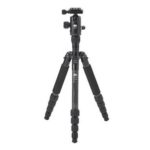 | 28oz | 54.7" | 13.2lbs | 12" |
| Trekking Pole Tripod | 2.3oz/8oz | * | 3.3lbs | * |
Manfrotto Elements Traveler CF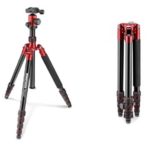 | 37oz | 56.3" | 8.8lbs | 12.6" |
MeFoto RoadTrip S CF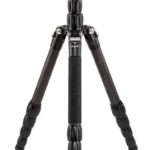 | 51.2oz | 61.6" | 17.6lbs | 15.4" |
Sirui AM-223 CF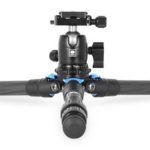 | 18.7oz | 13.8" | 31lbs | 12" |
Slik Mini Pro V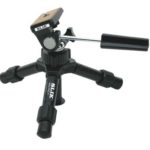 | 12.8oz | 9" | 2lbs 11oz | 7.9” |
Pedco Ultrapod II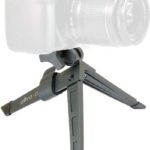 | 4oz | 5" | 10lbs | 7" |
Tips for Choosing a Lightweight Backpacking Tripod
Most tripods aren’t anywhere near the traditional definition of “ultralight,” especially if you want to use proper gear on them. However, it is possible to find lightweight tripods which can still perform. Here’s what you need to look for.
How Light Can You Realistically Go?
There are actually a lot of lightweight tripods out there. However, many didn’t make this list of best lightweight tripods because they have low max loads and are instability, making them practically useless for most backpacking photography.
Max Load
Lightweight tripods generally have very low maximum load weights. Some can only handle a few pounds. Do you really want to trust expensive gear on a flimsy tripod?
Aside from the risk of the entire tripod collapsing, there’s the issue of vibration. If you are shooting at longer focal lengths (which also probably means a heavy lens), those tiny vibrations will matter. What’s the point of bringing gear if it doesn’t serve your needs? Remember:
No matter how lightweight the tripod is, it’s dead weight if it doesn’t serve its purpose!
What max load should you get? As a general rule, aim for a max load which is 3x the weight of your camera, lens, and tripod head.
Wind Stability
Regardless of what the advertised max load is, a lot of lightweight tripods simply aren’t built to handle wind. It might only take a strong gust of wind to knock your tripod over, potentially destroying a lot of expensive gear in the process!
Tips:
- Wind speed is lower when you get close to the ground. Consider a short or tabletop tripod if going somewhere very windy.
- Tilt the camera over one of the tripod legs. This will give it extra stability against wind.
Ballast Hooks
A lot of lightweight tripods have ballast hooks so you can weigh them down. In theory this is supposed to make them more stable in windy weather.
Don’t rely too much on ballast hooks for stability though! The weight on the ballast hook cannot exceed the max load of the tripod. So, you can’t hang 10lbs to stabilize an UL tripod with a max load of 6lbs.
Adding weight in windy weather can also backfire. The weight hanging from the ballast hook starts to whip around and cause vibrations. It’s better to carry a heavier, more stable tripod than one which will be useless in wind.
Tips:
- Ballast hooks are great for keeping gear off the ground. This is the real reason you should want a ballast hook – not for stability.
- Use the rope trick. Tie a piece of rope from the ballast hook which is long enough to drag on the ground. Then you can step on the rope to pull it taught and stabilize the camera.
Carbon Fiber Is the Way to Go
Yes, carbon fiber versions of tripods are a lot more expensive than the aluminum versions. But it’s worth the cost for backpacking:
- Lighter: You can save a lot of weight by going with carbon fiber without scarifying stability.
- Handles abuse better: Carbon fiber is better at resisting corrosion, water damage, and scratching. This matters when backpacking!
- More stable: Because carbon fiber is stiffer than aluminum, it is more stable. This allows you to have a 4-section tripod without getting vibration noise.
Center Column
A tripod with a center column allows to you to get more height. However, the drawback is using the center column will make the camera less steady and more prone to vibration. It’s generally nice to have the option of a center column though as you can use it if you really need the height. With some tripods, like the Sirui 0-25x, you can even remove the center column. This saves you weight on trips where you won’t need it.
Tripod Height
When it comes to weight, tabletop tripods are the way to go. However, backpackers always need to balance out the need to go UL with convenience. Do you really want to crouch down on the ground every time you need to take a shot? Will having a low tabletop tripod cause you to miss certain shots? Will you be able to angle your camera up at the sky on a tabletop tripod?
As I’ve repeated multiple times: if gear doesn’t do what it’s supposed to, it’s dead weight. Better to carry a heavier full-length tripod than deal with a tabletop tripod if it won’t suit your needs.
Best Lightweight Backpacking Tripods
1. Sirui T-025X
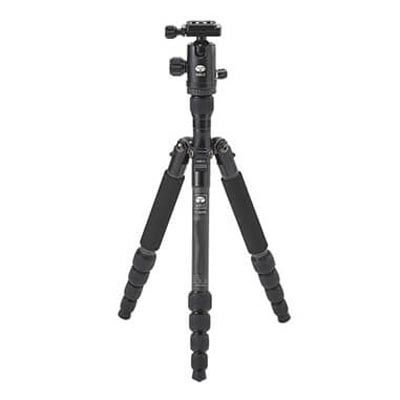
![]()
Quick Specs:
- Material: Carbon fiber
- Weight with Ball Head: 2lbs
- Max Load: 13.2lbs
- Collapsed Size: 12.2”
- Min-Max Height: 4.1”-58”
- Ballast Hook: Yes
- Locks: Twist
- Leg Sections: 5
- Ball head Included: Yes
- Spiked feet: No
- Buy here
The Sirui T-025x has been on the market for years now but it still remains the top tripod with many backpackers, especially those using lightweight mirrorless cameras. The tripod is also suitable for lighter DSLR cameras too.
The main perk of the Sirui T-025x is it weighs just 2lbs with the included Acra-Swiss compatible C-10X ball head. You can even remove the center column to make the tripod even lighter if you don’t mind sacrificing 10 inches of height.
Even though it’s such a lightweight tripod and has 5 leg sections, the T-025x is very stable. It is made of eight layers of carbon fiber. It’s great for nightscape shooting and long exposures, even with wind.
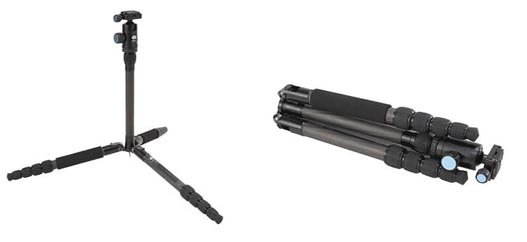
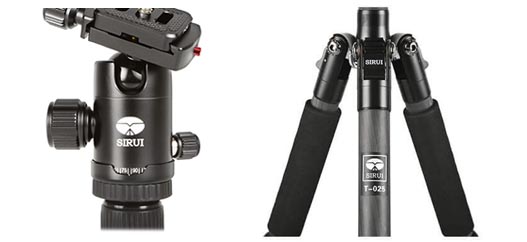
Another reason backpackers love this tripod is because it packs up so compact. The legs flip upwards 180 degrees so they sit along the main column.
To set up the tripod, you extend the legs down and they automatically lock in place. There is a locking system which lets you put the legs at 105, 130, or 190 degrees. The legs can be set individually to different positions if you want. The system is quick to use and very stable. The only annoying thing is that the tripod has 5 leg sections, so it takes a bit longer to set up to maximum height. That’s the price you pay for having a tripod which compacts down so small.
Is the tripod perfect for backpacking? No. It would be nice if there was an option for spike feet instead of just rubber feet. It would also be nice if one of the legs could be removed and used as a monopod. There’s also no bubble level. However, this is still considered the best all-around lightweight tripod for backpacking as well as travel. It’s not cheap, but it’s also affordable in “photo dollars.”

The image above was taken with a Fuji XT-1 with a 18-55 lens on the Sirui T-025X tripod. Credit: “Cimmarons Sunset” (CC BY-NC-ND 2.0) by David Kingham
2. Ultralight Trekking Pole Tripod
Quick Specs:
- Material: Carbon fiber
- Weight: 2.3oz (base), 0.85oz (ball head), 0.81oz (Arca Swiss clamp), 3.8oz (1 pole)
- Total weight: 8oz (with pole) or 5oz (with own pole)
- Max Load: 3.3lb
- Ball head Included: Yes
- Buy Here
This tripod is actually a base that allows you to use your trekking poles or branches as legs, thus allowing you to save a lot of weight. You can buy just the base here, or the set which includes one leg, an UL ball head, clamp, and phone head.
The entire setup is incredibly lightweight. However, it has its downfalls. For starters, it takes a while to set up. If you are the type of person who runs around with your camera setting up shots, then this isn’t for you. It’s really annoying to adjust the height of the tripod. If your poles are dirty, the tripod base will end up coated in dirt.
Get the Ultralight Trekking Pole Tripod Here
3. Manfrotto Elements Traveler Large Tripod
Quick Specs:
- Material: Carbon fiber (aluminum also available)
- Weight with Ball Head: 37oz
- Max Load: 8.8lbs
- Collapsed Size: 12.6”
- Min-Max Height: 13.78″-56.3”
- Ballast Hook: Yes
- Locks: Twist
- Leg Sections: 5
- Ball head Included: Yes
- Spiked feet: Yes
- Buy here
If you are only going to buy one tripod for backpacking and don’t mind a little bit extra weight, the Manfrotto Elements Traveler is probably the best choice.
The tripod is incredibly versatile in what it can do. You can attach the ball head to the top or bottom of the center column, meaning you can mount your camera upside down if you want. You’ll be able to get your camera almost exactly at ground level – perfect for macro photography.
The overall build of the tripod is very sturdy. The legs lock solidly without any wiggling in the joints. Yes, 5 joints mean it takes some time to extend the tripod but this is what you’d expect on a full-length travel tripod. The legs lock out at angles of 21.5, 54.5, and 83 degrees.
The ball head which is included with the tripod is a good quality which operates smoothly even in bad weather or sandy areas. It has full 360 degree panoramic rotation and quick release. There’s a bubble level built-in.
Yes, 37oz is a bit too heavy to be considered an ultralight tripod. However, it’s one of the lightest tripods which is still sturdy enough for serious gear. The Manfrotto Elements Traveler does have a cool option of removing one leg and attaching it to the center column to make a monopod. So, on trips where you don’t need a full tripod, this gives you a lighter alternative.
*Manfrotto also makes other great carbon fiber tripods, but they are over 4lbs with the ball head, so I didn’t include them here.
4. MeFoto RoadTrip Carbon Fiber
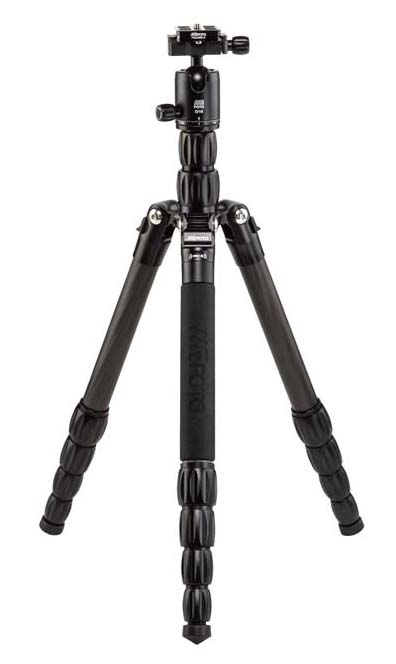
Quick Specs:
- Material: Carbon fiber
- Weight with Ball Head: 3.2lbs
- Max Load: 17.6lbs
- Collapsed Size: 15.4”
- Min-Max Height: 15.4”-61.6”
- Ballast Hook: Yes
- Locks: Twist
- Leg Sections: 5
- Ball head Included: Yes
- Spiked Feet: Yes
- Buy Here
The MeFoto RoadTrip carbon fiber tripod used to be very affordably-priced. Now, the price has shot up. At the time of writing, it’s nearly double the price of the Manfrotto Elements Travel CF tripod. However, it also has a very high weight limit considering how lightweight it is. It also holds up very well and can withstand a decent amount of abuse. I would still go with Manfrotto, as they are a more reputable and tested brand.
5. Sirui AM-223
Quick Specs:
- Material: Carbon fiber
- Tripod weight: 18.7oz
- Weight with Ball Head: 26oz
- Max Load: 31lbs (tripod), 22lbs (head)
- Collapsed Size: 12”
- Min-Max Height: 2.3″-13.8″
- Ballast Hook: Yes
- Locks: Twist
- Leg Sections: 3
- Ball head Included: Yes
- Spiked Feet: Yes
- Buy Here
Sirui recently released their AM-2 series of traveler tripods. Of the series, the AM-223 is the most impressive for lightweight backpacking.
The tripod itself is only 1.17lbs and it comes out to 1.62lbs with the ball head. Because there isn’t a center column, the tripod folds up very compact and is easy to carry.![]()
The max load of the tripod 31lbs. However, the included B-00K ballhead only has a max load of 22lbs. This ball head is suitable for most needs but is far from the best. You might want to replace it with the A-10R ball head (which is compatible with the tripod). It has a higher max load and more features like friction control. Unfortunately, you can’t buy the AM-223 tripod without the ball head. With some of the other tripods in the series, you can get just the legs.
The tripod performs really well in the backcountry. It is quick to and set up lock in place. The option for spiked legs is really useful in grass. The leg locking system is semi-automatic but only has one position plus a 90 degree option. This makes it possible to set up the tripod on uneven surfaces, but with a lot of limitations.
Considering the ball head is included and this is a carbon fiber tripod, the Sirui AM-223 is very affordable. The other tripods in the series are also affordable and all have a 6 year warranty.
Check out the AM-2 Series Here
6. Slik Mini Pro V
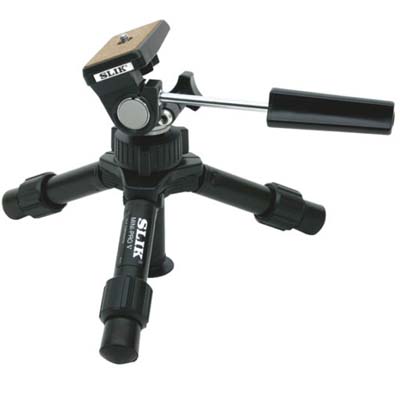
Quick Specs:
- Material: Aluminum
- Tripod Weight: 12.8oz
- Max Load: 2.7lbs
- Collapsed Size: 7.9”
- Min-Max Height: 6.1-9”
- Ballast Hook: No
- Locks: Twist
- Leg Sections: 2
- Ball head Included: Yes
- Spiked Feet: No
- Buy Here
If you find yourself bringing a larger tripod on backpacking trips but never actually need it, then it’s worth considering the Slik Mini Pro V tripod. It’s definitely tiny and compact and weighs in at 0.8lbs. I wish it were lighter for its size but, considering it is dirt cheap in photo dollars, it’s no surprise that it’s a bit heavier.
As the tripod only has a height range of 6-9 inches, it is obviously limited. Yet, there is still a center column and two leg sections which allow you to get some flexibility in shot heights. You can also utilize the center column as a chest pod.
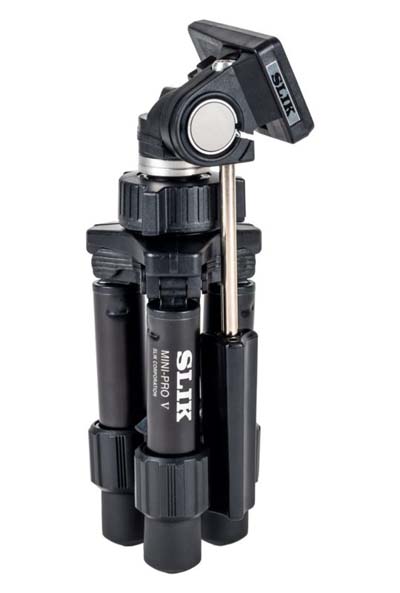
The tripod has plastic leg locks which will probably break if abused. It should be fine against your pack while backpacking, but definitely don’t leave it outside in bad weather.
A small gripe: I wish they could have made the center column slightly longer. As it is now, the camera can’t be tilted straight downward for vertical shots.
The bottom line? Choose this if you need something light and cheap for a mirrorless camera.
7. PEDCO UltraPod III Lightweight Camera Tripod
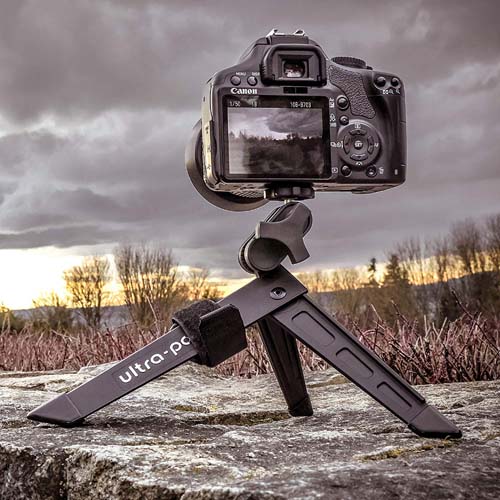
Quick Specs:
- Material: Aluminum
- Tripod Weight: 4oz
- Max Load: 10lbs
- Collapsed Size: 7”
- Min-Max Height: 5”
- Head: ¼-20 female thread
- Buy Here
The Pedco UltraPod III is even more basic than the Slik Mini Pro V listed above. It’s basically just three legs that support your camera. It has a max load of 6lbs, so could fit DSLRs. However, it’s really best for mirrorless and smaller cameras.
Despite how simple the tripod is, it has some cool features that make it useful for backpacking photography. First is the way the feet are made. They are slanted and spike-like, meaning it’s surprisingly stable. It only is 5” high off the ground, so you will need to find a rock or log to set up on unless you want to crawl around on your belly all the time.
To avoid the “belly shot” issue, the UltraPod comes with a Velcro strap. You can use the strap to attach the tripod to trees or your trekking poles. It actually works very well, so long as you don’t have bulky gear on the tripod. It also allows you to turn your trekking poles into a monopod.
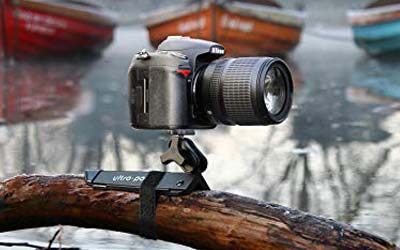
The major downside of the UltraPod is that it only shoots in landscape. If you want to shoot portrait mode with the tripod you will be out of luck. Other than that, it’s a damn good ultralight tripod that is insanely cheap.
What tripod do you use for backpacking? Let us know in the comments below!
Resources:
https://backpackinglight.com/forums/topic/2028/
https://backpackinglight.com/forums/topic/104765/
https://backpackinglight.com/forums/topic/lightweight-tripod/
https://backpackinglight.com/forums/topic/adding-to-tripod-stability/
https://commons.wikimedia.org/wiki/File:Gigapan_imager_on_Mt_Cargill.jpg


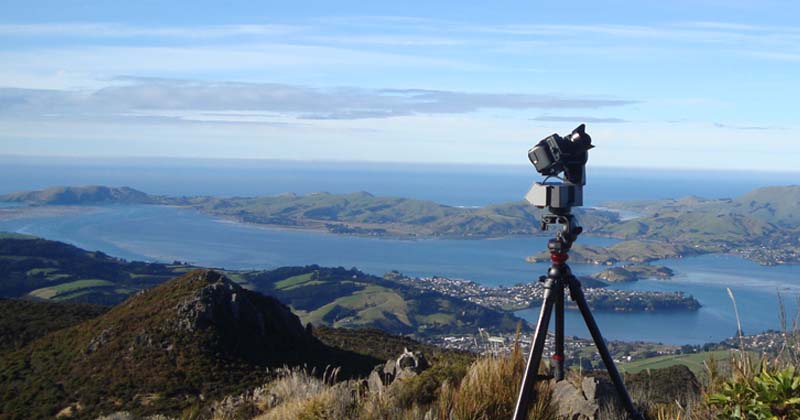
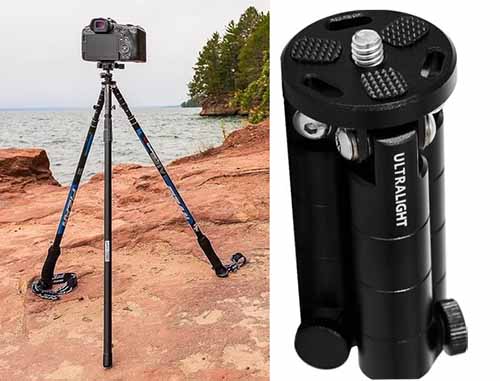
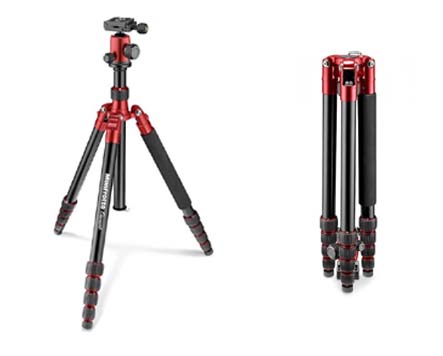
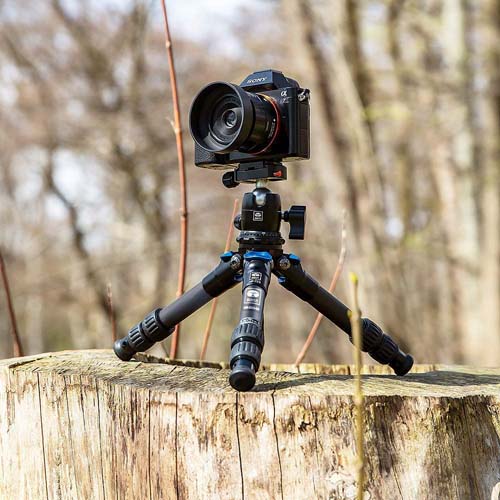
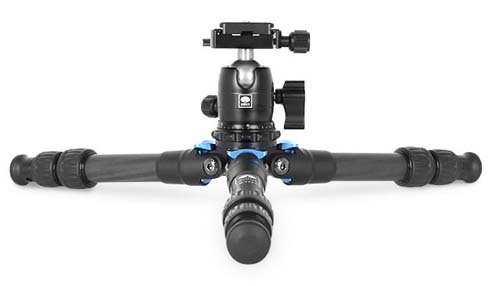
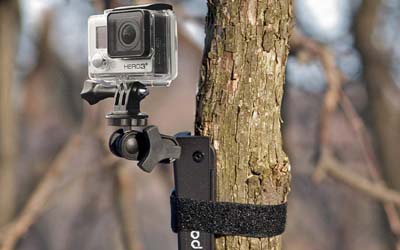

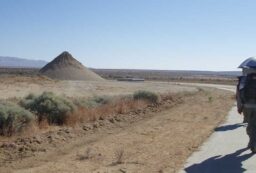
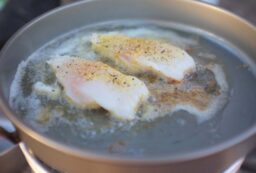







Post your comments